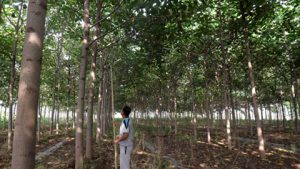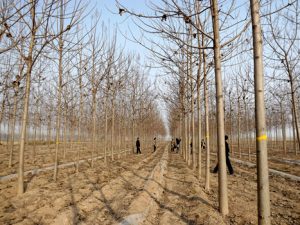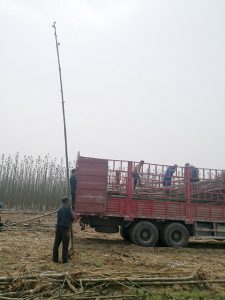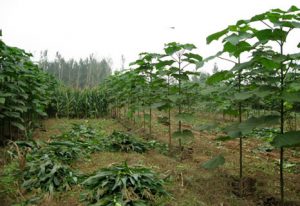The influence of different soil properties on the growth of paulownia
Soil is the most basic means of production for paulownia. It not only provides a place for paulownia to take root, but also provides it with the necessary water, nutrients, air and heat and other living conditions for life activities. Soils with different physical and chemical properties can provide different living conditions for paulownia.
The effect of soil physical properties on the growth of paulownia
Most species of Paulownia are deep-rooted trees with well-developed lateral roots. They are succulent and near-succulent roots. The cell parenchyma is relatively thin, the cell volume is large, and the root system is stretched. In addition to suitable water, heat, and fat conditions, it still needs The deep soil, loose texture, dampness, and good ventilation promote the paulownia roots to dig deeper, pierce quickly, and grow thick, so that the above-ground parts can grow well and reach deep and luxuriant roots.
The combination of different soil particle weight percentages at different levels in the soil is called soil texture. According to the classification standards of soil texture in my country’s forestry, it can be divided into three categories: sand, loam and clay.
Although Paulownia has relatively loose requirements for soil texture, it will show significantly different growth characteristics when grown on different soil textures. For example: Paulownia growing on clay with poor soil aeration or some heavy loam soils often grow poorly due to lack of oxygen at the roots, especially when it encounters rainfall, it is easy to rot the roots. If it is not drained in time, it may cause problems within a few days. Falling leaves and even death.
The influence of soil chemical properties on the growth of paulownia
The main manifestation of the chemical properties of the soil is the acidity and alkalinity of the soil. Its strength is usually measured by the pH value and expressed by the PH value. It widely affects soil nutrients, fertilizer retention, soil properties, plant growth, etc., and is one of the important characteristics of soil.
The acidity and alkalinity of the soil has a very obvious impact on the soil fertility and the growth of paulownia, which are manifested in the following aspects:
(1) The acidity and alkalinity of the soil affect the availability of soil nutrients: the nutrients in the soil are closely related to the acidity and alkalinity. Only within a certain pH range, a certain nutrient is most effective, and Paulownia can be effectively absorbed. This range will reduce its effectiveness, that is, reduce the effective nutrients that paulownia can absorb and utilize. For example, when the pH value of phosphorus in the soil is 6.0-7.5, the effectiveness is best, and the effectiveness beyond this range is significantly reduced.
(2) Impact on soil structure: strong acid and strong alkaline soils are difficult to form a good soil structure, which is not conducive to the growth of paulownia.
(3) Effects on soil microorganisms: soils that are too acidic or too alkaline will inhibit the activities of microorganisms, thereby affecting the decomposition and synthesis of organic matter, and seriously interfering with the transformation and supply of nitrogen and other nutrients. It is difficult to provide direct access to paulownia. Effective nutrients absorbed.
(4) Impact on the growth of paulownia: overly acid or too alkaline soil will produce substances that are toxic to paulownia. The soil is too acidic to easily produce free AI3+ and organic acids, which directly harm paulownia. When the soluble salt in alkaline soil reaches a certain amount, it will directly affect the germination and normal growth of paulownia. Different paulownia varieties have different requirements for soil acid-base reaction. The paulownia varieties with stronger adaptability have a wider suitable pH range, and vice versa.The influence of soil salinity on the growth of paulownia.
The amount of salt in the soil has a significant impact on the growth of paulownia. It grows on paulownia with high soil salinity, the growth of the above-ground part is obviously weak, and the root system is mostly brown fibrous roots, which can cause rotten roots to death in severe cases. According to our test results on the influence of different salinity on the growth of paulownia, as the salinity increases, the toxic effect of the base will have a significant impact on both the above-ground part of the paulownia and the underground root system. According to the determination of salt tolerance, the growth of the more resistant paulownia varieties grown on the same medium-saline afforestation land was significantly greater than that of the weaker paulownia varieties. Therefore, different paulownia varieties have different salt tolerance.
The influence of soil nutrients on the growth of paulownia
Paulownia is very sensitive to soil nutrients. The content of each element in the soil is an important factor affecting the growth of paulownia. According to experiments, under roughly the same conditions, except for other factors such as paulownia varieties, the soil nutrient content is different, and the diameter at breast height growth of 6-year-old paulownia differs by 1.6 times.
Like other plants, paulownia absorbs the nutrients in the soil in a certain proportion, and the different ratios of effective components among the nutrient elements are important factors affecting the growth of paulownia. The various effective nutrients that can be absorbed by paulownia are controlled by soil structure, pH and soil salinity. Only by first measuring the physical and chemical properties of the soil and soil nutrients and salinity can we scientifically implement formula fertilization to achieve fast growth of paulownia The purpose of fertility.






It’s the best time to make a few plans for the long
run and it is time to be happy. I’ve learn this publish and if I may just I wish to counsel you some attention-grabbing issues or advice.
Perhaps you can write subsequent articles regarding this article.
I want to learn more issues about it!
Excellent website you have here but I was wondering if you knew of any discussion boards that cover the same topics talked about here?
I’d really like to be a part of community where I can get suggestions from
other experienced people that share the same interest.
If you have any recommendations, please let me know. Thank you!
Neat blog! Is your theme custom made or did you download it from somewhere?
A theme like yours with a few simple tweeks would really make my
blog stand out. Please let me know where you got your design. Bless you
Hi to every body, it’s my first pay a quick visit of this website;
this web site includes awesome and in fact excellent information for
readers.
Thank you for your message.